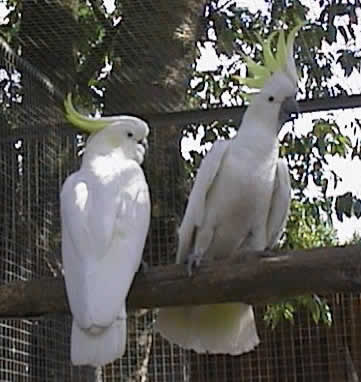
Greater Sulphur-crested Cockatoos make very loving pets that need lots of attention. They can learn to talk, as can most cockatoos and are easy to teach all kinds of tricks!
The Greater Sulphur-crested Cockatoo has been a well known bird for many years. It was collected as early as 1790 by the famous explorer, Captain Cook, on one of his voyages to Australia. They can be very long lived with one bird recorded as living for about 120 years.
This bird is a very delightful and sweet tempered. Like cockatoos in general, they are a very loving type of bird. Affection is readily accepted and returned in kind. They are a pet that not only appreciates interaction but requires it and needs a lot of attention from their owners. Buy a cockatoo only if you can spend a lot of time with it.
To learn more about Cockatoos and their needs visit:
Guide to a Happy, Healthy Cockatoo
- Kingdom: Animalia
- Phylum: Chordata
- Class: Aves
- Order: Psittaciformes
- Family: Cacatuidae
- Genus: Cacatua
- Species: galerita
Scientific name:
Subspecies – (4):
- Greater Sulphur-crested Cockatoo
Cacatua galerita galerita - Triton Cockatoo
Cacatua galerita triton - Medium Sulphur-crested Cockatoo
(also called: Eleonora Cockatoo)
Cacatua galerita eleonora - Cacatua galerita fitzroyi
Distribution:
These birds can be found in New Guinea including the offshore islands, Aru islands, and northern and eastern Australia. It has been introduced to other places including New Zealand, the Palau Islands, and Indonesia.
Description:
Greater Sulphur-crested Cockatoos are a full-sized cockatoo. They are primarily white with a yellow or “sulphur” colored crest on the top of their head. The underside of the wings and tail is also frequently tinged with yellow. Mature birds are about 48 cm (19 inches) in length. They are among the largest cockatoos.
In many respects the Greater Sulphur-crested Cockatoo resembles the Lesser Sulphur-crested Cockatoo. Technically these two species would be referred to as ‘superspecies’, meaning two similar species that are geographically separated. Besides size, the Greater Sulphur-crested being a larger bird, there are a few other criteria used to identify them. The Lesser Sulphur-crested Cockatoos have a heavier, wider, and less protruding beak, their crest is usually narrower, and the bare skin around their eyes is much whiter.
Birds that are called the ‘Medium Sulphur-crested Cockatoo’ are generally the Eleanora Cockatoo Cacatua galerita eleonora, a subspecies of Greater Sulphur-crested Cockatoo, though in earlier writings this term sometimes referred to larger individuals of the Lesser Sulphur-crested Cockatoo.
Care and feeding:
A roomy cage is required (minimum 2 ft. x 2 ft. x 3 ft. high) unless the bird is to be let out for extended periods. Many birds can spend most of their time on a play pen or parrot perch.
They eat a variety of seeds, nuts, fruits, and commercial pellets, as well as the same nutritional foods humans eat.
See About Cockatoos: Housing and About Cockatoos: Care and Feeding for more information.
Social Behaviors:
In the wild Cockatoos are friendly and peaceful. They live together in flocks of 20 or more birds.
They enjoy and require a lot of affection and attention. It is often recommended that they be kept in pairs so they will keep each other company. This can help to reduce the amount of time you will have to devote to an individual bird.
Breeding/Reproduction:
See About Cockatoos: Breeding for Cockatoo breeding information.
Sexual differences:
Hard to tell the sex of young birds. As they get older the iris of the females’ eyes will develop a reddish color, the males’ eyes will remain black. This is not always completely accurate so other means are necessary if you need to know “for sure” what sex a particular bird is.
Potential Problems:
Cockatoos can be quite loud screeches. The behavior can be reduced by giving attention and proper surroundings. Also, since they are prone to chewing, if they are not given enough attention they will chew their own feathers.
See About Cockatoos: Potential Problems for information on illnesses.
Availability:
These birds are available from time to time.
Activities:
Loves to climb and play and chew. Provide lots of toys.
Featured Image Credit: Martin Pelanek, Shutterstock
